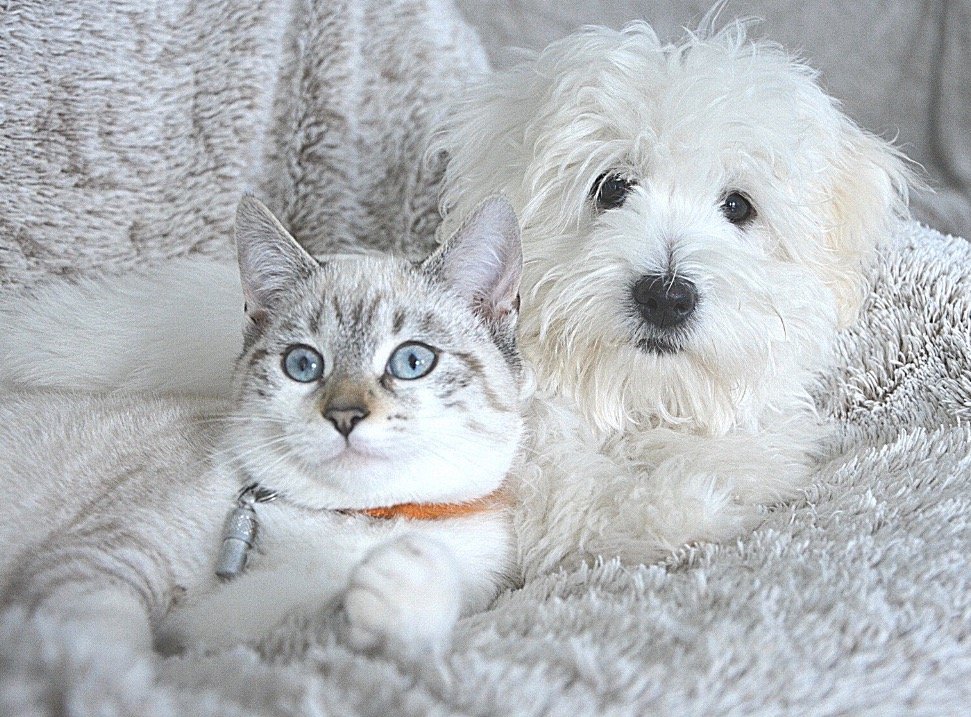How to Stop Your Cat From Stealing Your Dog's Bed
If your cat is always stealing your dog’s bed, it can make your pets (and you) stressed out. In this post, you'll get the full breakdown of how to stop your cat from resting in your dog’s spot (and how to figure out whether you need to stop the behavior at all).
Quick disclaimer: To make it easier for you to differentiate between the animals in this post, I consistently use he/him pronouns to describe the dog and she/her pronouns to describe the cat. Of course, your dog(s) might be female and your cat(s) might be male!
Is it okay for my cat to hang out in my dog's bed?
It depends!
Some dogs don’t mind sharing their bed with their feline housemate - they might even enjoy having their cat friend around. If that’s the case, then there may be no issue at all.
But if your dog and cat were already best friends and snuggling together constantly, you probably wouldn’t be reading this post 😉
So in the case of your bed-stealing cat, the first step is to analyze whether it’s a problem behavior you need to address or whether you can prioritize other coexistence training projects.
These 3 questions will help you determine if your cat hanging out in your dog's resting area is actually an issue:
How does your dog feel about his bed?
What does your dog’s body language look like when the cat is in his spot?
When your dog approaches them on the bed, what does your cat’s body language look like?
How does your dog feel about his bed?
If he doesn’t use it much? Probably wouldn’t even notice if it moved around the house or was thrown out? You might be able to just go with the flow and let the cat take it over.
But if your dog’s bed has been his go-to safe space to relax and decompress, the cat taking it over is most likely affecting his quality of life. Here are some things to consider:
Does your dog have other comfy places in the house where he regularly hangs out? Or is this bed (that the cat is constantly chilling in) his go-to spot?
Is your dog’s bed the place he went to decompress when stressed? If so, has he found another safe space to head to when he’s feeling overwhelmed?
Is your dog more restless, getting up and shifting around the house more often… when he used to take long, quality naps in his bed?
If your dog hasn’t found other places to get quality rest and is literally losing sleep since the cat took over his bed, check out how to evict the cat sooner rather than later.
What does your dog’s body language look like?
When your dog notices that the cat is in his bed, what does he do?
If he easily disengages and moves away to find a different spot to rest, great! He might be OK with letting the cat take this “shift” and you can probably let sleeping cats lie for a while 😉
But you’ll need to address the issue if he sticks around and does some of the following behaviors:
tentatively moving towards the bed (slowly approaching and then retreating a few steps, trying again from another angle)
pawing at the bed
sniffing the ground right near the bed
rushing towards the cat
vocalizing (whining, huffing, barking at the cat)
hanging around and staring at the cat, immediately taking over the bed as soon as the cat gets up
If your dog is displaying any of these signs of stress or annoyance when he sees the cat in his spot, here’s how to teach your cat to find other places to chill.
What does your cat’s body language look like?
If your cat is already on the bed when your dog approaches, how does she react?
If she glances up and calmly watches to see whether the dog wants to get on the bed, or casually gets up and walks away, your pets are communicating well! They’ve likely already figured out a way to share that resting spot.
But you might see the cat getting defensive and making it clear that the dog isn’t allowed any closer. Look for body language like this:
ears pinned back
hissing or low growl
hard stare
stiff body
piloerection (the hair on the back or tail puffs up)
paw(s) reaching out to swat (with or without claws)
won’t readily leave the bed to follow treats, toys, or anything else she is typically interested in
So if your cat gets pissed when your dog wants to chill in his own bed, it's important to encourage her to find different (but equally as awesome) resting spots.
IMPORTANT: If your pets are getting into intense conflict over resting spots or in other specific contexts - even if it happens very rarely - you need to address it quickly (and hire a professional to help you).
How to keep your cat out of your dog’s bed
What’s the best way to train your cat to stay out of your dog’s bed? The short answer is to make the dog’s bed less inviting and make other resting spots more appealing.
Let’s break that down into a 5-phase training plan:
Track your cat’s current “resting routine”
Make it harder for your cat to get to your dog’s bed
Reward your cat for resting in other places
Offer equally (or even more) comfortable “alternative resting spots”
Make hanging out in those new spots better/easier than taking over the dog’s spot
Track your cat’s “resting routine”
Most cats have multiple spots around the house where they tend to hang out (not just your dog’s bed). Some cats even develop a fairly predictable pattern where they move from room to room or perch to perch at certain times of day.
So before you get started with training, you want to observe your cat for 1-2 days and answer these questions:
How often is your cat choosing the dog’s bed as their chill spot? When does that tend to happen?
Where else in the house do they tend to rest? Do you have a good idea of where they will be throughout the day?
Do they follow you from room to room? Or hang out on their own? Is their routine different when you are home vs. when you’re out of the house?
Download this template to be able to easily make note of your cat’s baseline resting routine!
Make it more difficult to reach the bed
The best way to reduce bed-related conflict between your pets is to prevent your cat from having access to the dog’s bed in the first place. There are two main ways to do this: putting physical barriers around the bed and redirecting the cat away from the bed.
Block off access to the bed (if possible)
When you aren’t able to directly supervise the cat’s movements around the house, you’ll want to prevent her from being able to get to it. Here are a few ideas for cat-proof physical barriers:
Designate a certain room as your dog’s chill zone (and keep the cat out by closing the door or putting up a cat-proof double gate [link to the baby gate guide])
when your dog heads to his bed for a snooze, close the door so the cat can’t follow and disturb his rest
when he gets up and leaves the room, close the door behind him to prevent the cat from hopping into the unoccupied bed
Create a cat-free zone around your dog’s bed
enclose the bed inside an extra-large crate (like this one) or an ex-pen with a blanket on top
Of course, these types of physical barriers might not be practical for you, depending on how your house is set up, your pets’ routine, and their ability to be confined. That’s OK! Redirection is also an option.
Redirect the cat away from the dog’s bed
When you’re able to supervise and actively manage your cat’s behavior, you’ll want to watch for when she approaches your dog’s bed and ask her to move away instead of settling there.
Here are a few common (low-stress) ways to interrupt a cat who’s on her way to the dog’s bed:
an attention-getting noise: try “pss-pss” or a kissy noise or "kitty kitty” etc. Avoid using your cat’s name in this situation (and definitely don’t repeat it over and over if they don’t respond immediately).
The “whiplash turn”: a cue - trained with positive reinforcement - for your cat to look away from whatever they are looking at or moving towards in order to find you/move towards you (here’s a demo video)
“Touch”: a cue - trained with positive reinforcement - for your cat to come to you and touch their nose to your outstretched finger (here’s a demo video)
picking her up (MAYBE): this is not my first choice of techniques, but it can be effective for some cats (if they relax into you when being handled and moved around, not just tolerating it)
Whenever possible, avoid using a harsh tone or loud noise to startle the cat. It’s probably not going to effectively stop the behavior (and might make her less likely to respond to you in the future).
Important: don’t rely exclusively on redirection to try to “fix” the problem behavior - use it sparingly. Otherwise, your cat will quickly learn to go to the dog’s bed in order to be called away and get attention or treats from you. The most important part of the training plan is reinforcing your cat when they aren’t in your dog’s bed (see the next sections). If you’re having trouble with this, contact a professional trainer who has experience working with cats without the use of force or intimidation.
Reward your cat for choosing to rest in other places
Now that you’re making it more difficult for your cat to get to your dog’s favorite resting spot, you’ll want to keep an eye out for when she’s choosing to chill anywhere that isn’t your dog’s bed.
Whenever you catch your cat relaxing in these other spots, calmly reinforce that behavior.
The easiest way to do this is to give them positive attention:
petting (if they enjoy being touched - and it relaxes them)
praise (avoid using an exciting, high pitched tone of voice)
sitting nearby (if they tend to seek your company) and/or food rewards:
And if your cat is interested in food rewards, you can also deliver a treat right to them (so they don’t have to get up to eat).
Pro tip: if your cat has some elevated perches, put some treats on them occasionally for her to find - surprise!
Whatever rewards you decide to use, make sure that they don’t make your cat too excited. You want to further their relaxation, not interrupt it.
Here’s the cool thing: just doing these first two steps might take care of the problem all on its own! For 3-5 days, consistently reward your cat throughout the day as she chooses to rest in non-dog bed locations. Then compare her new resting routine to the baseline - you might find that she already isn’t as into the dog’s bed as she was before.
Provide more comfy spots for resting
If your cat is still focused on your dog’s bed and isn’t reliably choosing other places to hang out, try to figure out what she thinks is so awesome about it! Then incorporate those things into more cat-friendly spots in the house.
Your cat might be interested in the dog’s bed because of specific characteristics of the bed itself or based on where it’s placed in your home. Here are some examples:
If you’re not sure what is making your cat so jazzed about the dog’s bed, ask yourself these questions:
Are there any other places in the house that provide the same sensory experience as the dog’s bed? e.g. if the dog has a donut bed and all of the cat’s resting locations are made of carpet (like in a cat tree) or a more standard mat
Are there any other places in the house that provide the same social and environmental experiences as the dog’s bed? e.g. a near a radiator for warmth and out of the way of chaotic kids running around
Once you have an idea of what your cat might enjoy in her ideal resting spot, try to improve a few places around the house to incorporate those characteristics.
Work on the “Cat-Dog Relaxation Protocol”
Now that you’ve created (theoretically) awesome resting spots for your cat, let’s get her really wanting to hang out there!
I’ve designed the Cat-Dog Relaxation Protocol to positively reinforce your cat for relaxing in a certain spot, in increasingly distracting environments. It’s a cat-and-dog-specific adaptation of Dr. Karen Overall's Protocol for Relaxation that gives you step-by-step instructions to take your cat from just touching a mat with her paws to chilling out in her new favorite place (even with the dog around).
After working through the initial training steps, you’ll already start to see your cat choose her new spot more often.
And when you do catch her chilling out in the right place? Reward the heck out of that cat!
Seek Professional Help
If your cat and dog are struggling to share space and not getting along despite your best efforts, it may be time to seek out a certified behavior professional who trains with methods that don’t use fear or intimidation. Your trainer can provide specific advice on how to manage the situation and prevent conflicts from arising.
In conclusion, if your cat is stealing your dog's bed and it’s causing a problem, it's important to take action to promote peaceful coexistence. By providing physical barriers, offering equally comfortable alternatives, rewarding the behavior you want to see, practicing the Cat-Dog Relaxation Protocol, and seeking professional help if needed, you can help your furry friends live together in harmony.




